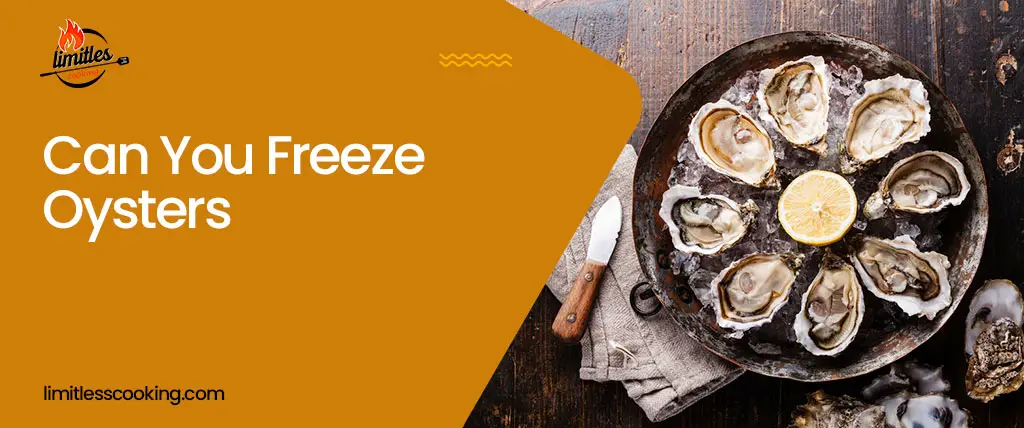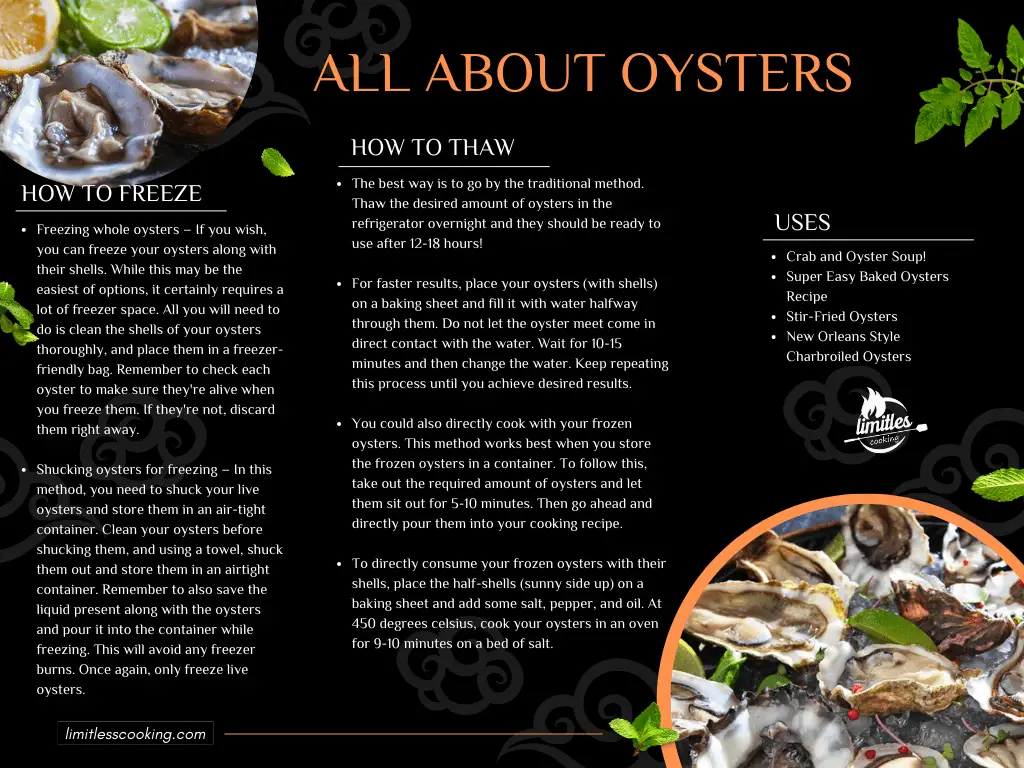Can You Freeze Oysters? How Long Can You Freeze It?

Oysters are a delicacy. They’re rich in zinc and are known for a wild variety of health benefits. Not to mention, people around the world enjoy having oysters in many forms.
So, if you ever spot a huge discount on oysters at some point and wonder if you could just buy them in bulk and freeze them to enjoy them at some other time, then we have good news for you.
The answer to your question, “can you freeze oysters?” Yes, you can. Let’s dive into the best methods of storing oysters so they’ll last longer and other important discussions on freezing oysters.
Oysters’ Nutrition Information
Oysters are very healthy and the nutritional value of oysters is not significantly changed by any cooking or preparation techniques.
6 medium-sized oysters can provide approximately:
- Calories: 50
- Carbohydrates: 5 grams
- Fat: 1 gram
- Protein: 6 grams
- Fiber: 0 grams
Raw oysters are a rich source of numerous vitamins and minerals. They are an excellent source of vitamin B12, which studies have shown is crucial for maintaining the health of your brain. Some more micronutrients are:
- Iron
- Vitamin D
- Magnesium
- Phosphorus
- Manganese
- Copper
- Zinc
- Selenium
Can You Freeze Oysters?
The good news is Yes, you can! You can store them in the fridge, or freeze them, to extend their shelf life. If done right, your oysters will be completely safe to use, and you will have a load of delicious food waiting in the freezer whenever you want to eat it!
BUT there are a couple of things you should know before you run around buying oysters at a discount.
- While freezing your oysters is possible, it will have an effect on their taste once thawed. Frozen oysters will never taste as good as fresh ones!
- To ensure that your oysters stay fresh for a long time once frozen, buy your oysters from a reputed fish market/grocery store. Make sure they’re fresh, of good quality, and alive when you buy them.
- Frozen oysters are not meant to be consumed raw. Freezing your oysters leads to bacterial growth that is unsafe and dangerous.
How Can You Freeze Oysters?
There are four ways you could freeze oysters. Fortunately, all of them are extremely easy to follow!
1. How Can You Freeze Fresh and Whole Oysters?
Follow the below steps to freeze fresh oysters.
Step 1: Tap oysters’ shells one by one to see if they are still alive. You should always eat, freeze, or cook alive oysters to prevent the spread of foodborne illness.
A live, fresh oyster will hold its shell tightly shut when you tap on it, or it will close if it has been opened.
Step 2: Thoroughly wash the shells in cool running water before freezing the oysters. You can also use a stiff-bristled brush to gently scrape the shell’s exterior and remove any dirt.
Step 3: Place whole oysters in resealable, moisture-resistant freezer bags. You won’t have to do anything else as the shells will keep the oysters protected from any damage.
2. How to Freeze Half-Shell Oysters?
You can freeze half-shell oysters by following the below instructions.
Step 1: Check if the oysters are alive. When you tap, an oyster that is still alive uses its muscle to keep its shell tightly shut or slam shut its shell if it is open. After tapping, if it remains open, discard the oyster as it is dead.
Step 2: Wash the shells under running water and use a brush to remove any sand, mud, or dirt on the outside of the oysters.
Step 3: Since oysters’ shells are so sharp, use a glove or a dish towel to hold the oyster to prevent any cuts. This way, you’ll also have a better grip on the oyster.
Step 4: Use an oyster knife and carefully slide it into the hinge or pointed edge of the oyster’s shell. Keep twisting until you hear a pop.
To release the oyster from the shell, cut along its top edge with a knife. Then, break the top shell off. To preserve the most oyster liquid, keep the oyster upright.
Step 5: Put oysters in their shells in a shallow container. Leave some space on the top of the container, then seal the container and put it in the freezer.
Be careful when laying the oysters flat to prevent spillage of the oysters’ juices because they are quite flavorful. Additionally, it will keep the oysters hydrated and plump while they are frozen.
3. Shucking Oysters for Freezing
Step 1: Wash the oysters’ shells under cold water before you shuck them to remove any sand, debris, and bacteria from the shells.
Step 2: Put on some thick gloves to protect your hands from the sharp oyster shells. For the best result, you can wear rubber or canvas gloves. Wearing gloves will also improve your grip on the oysters as you shuck them.
Step 3: Tap oysters individually to ensure they are alive. Discard dead oysters as bacteria grows quickly on dead shellfishes.
Step 4: Oysters naturally contain a juice known as the liquor that has a rich flavor. To retain that liquor inside, place the oysters over a bowl.
If you save the juice, then when you thaw out your frozen oysters, you can add it to any recipe you’re making with them to enhance the oyster flavor.
The oyster’s liquid interior should be transparent or barely opaque. Throw away the entire oyster if it is hazy or yellowish.
Step 5: Place the curved side of the oyster down in your hand. One side of the oyster should appear more rounded, and the other should appear more flat when you look at it.
The oyster’s pointed end should be facing you, with the curved side resting against your palm.
Step 6: To separate the top and bottom shells, insert the knife into the hinge. There should be a little opening where you can insert the tip of your oyster knife at the hinge at the oyster’s pointed end.
If you need, you can move the knife tip around to help slide it into the hinge.
Step 7: Keep twisting the knife back and forth until you feel the oyster pop as the shell releases.
For shucking oysters, oyster knives work best. But you can use butter knives too.
Step 8: To separate the top and bottom shells, move the blade along the shell’s top. As a result, the muscle holding the oyster to the top shell will be cut.
Then remove and discard the top shell. Then tilt the oyster to pour its liquor into the bowl.
Step 9: Use the knife to separate the oyster meat from the bottom shell. To free the oyster, smoothly run the blade beneath the oyster. Then you can toss away the bottom shell as well
Step 10: To store oyster meat, place them in a freezer-safe container and cover them in oyster liquor.
If the liquor isn’t sufficient to cover the oysters, you can add a little water to the container.
4. How to Freeze Cooked Oysters?
You can also freeze cooked oysters. Here are the steps to follow.
Step 1: Spread the cooked oyster on the bottom of a freezer-friendly container. Keep the oysters in only a single layer in a container. If you have more oysters than will fit into one container, use as many containers as necessary.
Step 2: Cover the oysters in the container with the cooking liquid you used to prepare them. The liquid will lessen ice crystals’ formation and assist in stabilizing the oysters.
Step 3: If your freezer has colder temperature settings, lower the temperature to zero degrees Fahrenheit or lower. It is preferable to freeze the oyster meat as soon as possible.
Step 4: Place the oyster containers in the freezer, then wait for the liquids to completely freeze solid before removing them. When the oysters are being frozen, try to avoid opening the door or moving the containers because doing so will reduce their freshness.
How Long Can You Freeze Oysters for?
Like most other frozen foods, oysters have a far longer shelf life in the freezer than they do when they are fresh. So, oysters can be safely consumed for up to 12 months after being frozen.
Nevertheless, it is preferable to consider these 12 months as the “best before” rather than the “use by” date. Frozen oysters can’t spoil. Therefore, they remain safe to eat even after these 12 months have passed.
However, as their quality will be good for the 12 months, it is advised that you consume them during this time. Once these 12 months have passed, the oysters’ condition will start to worsen, but they will still be absolutely safe to eat.

You may also like: Can You Freeze Guacamole
How to Tell If Frozen Oysters Have Gone Bad?
Oysters that have gone bad are very easy to spot. And you must look for these few signs to know if your oysters are still safe to eat.
Eating spoiled oysters can lead to food poisoning, and can sometimes be potentially life-threatening to some people. You must discard any spoiled oysters immediately.
To check for the freshness of your oysters you need to look at their color, texture, and smell. Spoiled oysters usually turn grey, brown, black, or even pink. They develop a cloudy film on their surface and become very dry. Spoiled oysters will smell very pungent and have an intense odor. If you spot any of these symptoms, do not risk eating them.
You may also like: Can You Freeze Tuna Salad

Can You Eat Frozen Oysters Raw?
Don’t. No matter how many days or weeks they have been in the freezer, once you freeze your oysters you should never have them raw.
Freezing oysters kills them. Once dead, your oysters develop bacterial growth that is harmful and dangerous for you. Cooking or baking oysters kill these bacteria, making them safe to eat. But having them raw is extremely unsafe.
How to Thaw Frozen Oysters?
There are a variety of techniques you could try to thaw your frozen oysters, some of them quicker than others.
- The best way is to go by the traditional method. Thaw the desired amount of oysters in the refrigerator overnight and they should be ready to use after 12-18 hours!
- For faster results, place your oysters (with shells) on a baking sheet and fill it with water halfway through them. Do not let the oyster meet come in direct contact with the water. Wait for 10-15 minutes and then change the water. Keep repeating this process until you achieve desired results.
- You could also directly cook with your frozen oysters. This method works best when you store frozen oysters in a container. To follow this, take out the required amount of oysters and let them sit out for 5-10 minutes. Then go ahead and directly pour them into your cooking recipe.
- To directly consume your frozen oysters with their shells, place the half-shells (sunny side up) on a baking sheet and add some salt, pepper, and oil. At 450 degrees celsius, cook your oysters in an oven for 9-10 minutes on a bed of salt.
While all of these methods work, I would always recommend thawing them evenly in the refrigerator overnight. This method would make the best out of your frozen oysters once they’re thawed.
What Can You Do With Frozen Oysters?
So many things! You can grill them, bake them, add them to your soups and casseroles, or even stews and gravies! Find some of my favorite frozen oyster recipes below!
- Crab and Oyster Soup!
- Super Easy Baked Oysters Recipe
- Stir-Fried Oysters
- New Orleans Style Charbroiled Oysters
FAQ
Can I freeze oysters if their shells are open?
If an oyster does not shut its shell once you tap on it, it is dead. Never use dead oysters, whether for freeing, eating them raw, or cooking them.
Can you freeze oysters in a jar?
Live oysters can be shucked and stored in a jar along with their liquor. The jar should be air-tight and freezer friendly for longer shelf life.
Can you refreeze oysters?
Don’t ever freeze oysters that have already been frozen once. It is better and safer to only take out the desired number of frozen oysters from the freezer instead of thawing the whole batch and refreezing them.
Do oysters die when frozen?
Yes, the freezing process kills oysters. This is why you should never eat frozen oysters in raw form. Always cook them before consumption.
Can you freeze raw oysters?
Yes, you can freeze raw oysters using one of the above methods.
Can you freeze oysters in the shell?
A big yes. People mostly freeze fresh oysters whole, in their shells.
Final Thoughts
Don’t let anyone tell you that you can’t freeze oysters. You can! If you follow our guide right and take all the necessary precautions, you will have a super delicious meal tucked in your freezer, ready for when you crave it! There are many, many things you can do with frozen oysters. Don’t let anything hold you back!






